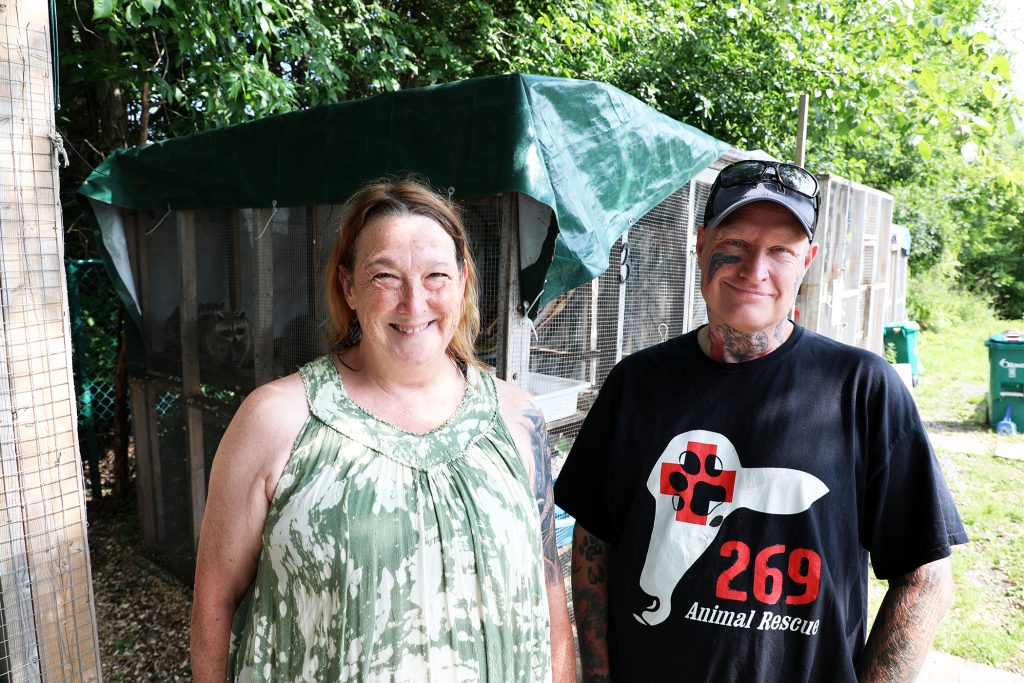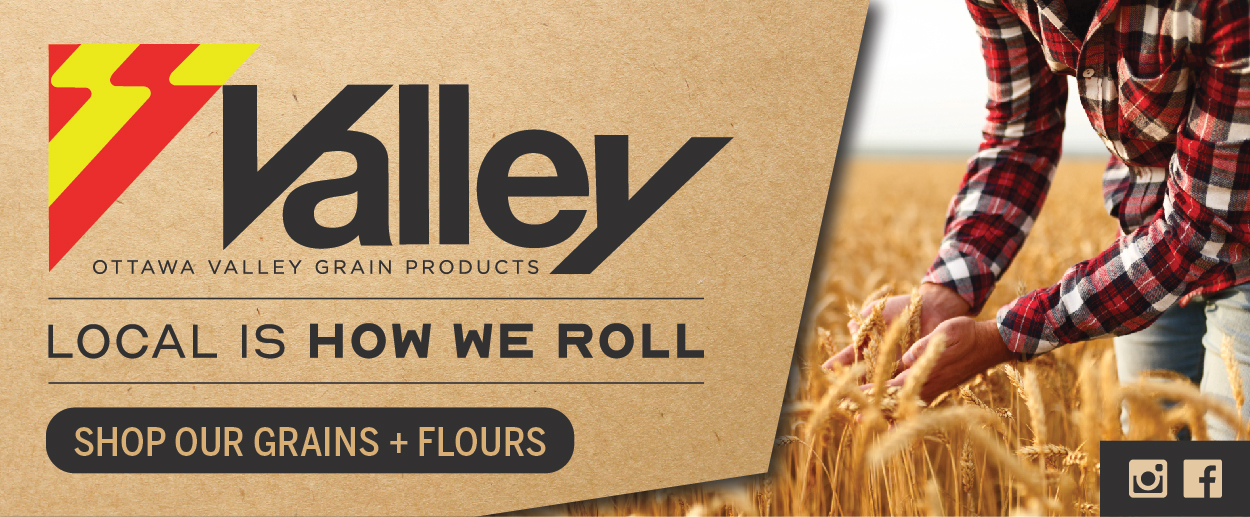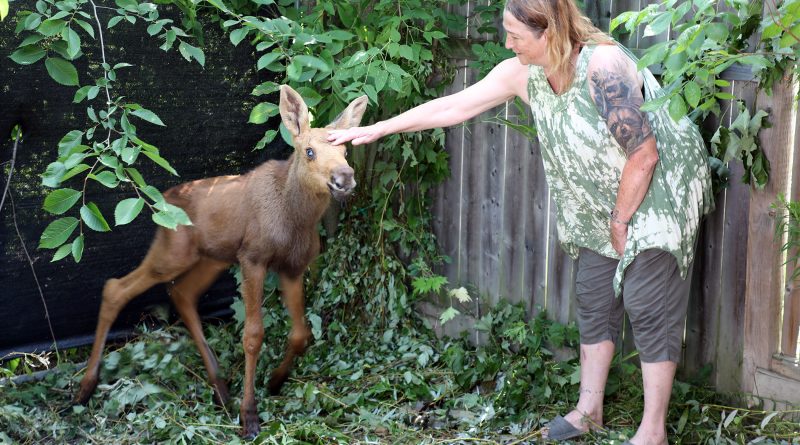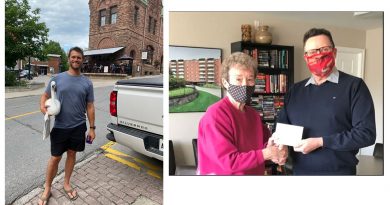Holly’s Haven hosts Cedar the moose
By Jake Davies - West Carleton Online
DUNROBIN – It’s a busy time at Holly’s Haven Wildlife Rescue with more than 70 wild animals currently under its care. And for the first time ever, a moose.

On July 7, 269 Animal Rescue’s Rob Boisvert delivered the very young moose calf to Dunrobin’s Holly’s Haven operated by Lynne Rowe after finding it lost and calling for its mother near St. Isadore, ON. It had an injured back leg, very limited vision due to an eye issue and was desperately searching for its mother.
Boisvert lifted the moose up and got it in to its car. He estimates it weighed around 60 or 70 pounds.
“I have a lot of people who know me in Quebec, and a friend of mine that runs a pet food store in Rigaud, QC, she saw it in the field,” Boisvert said. “When she noticed the blindness and everything else, and that it was starting to head towards the road, she was right on the phone. At the time, I was only 15 minutes from there, so I raced there fast.”
The pair estimate the calf was about two months old.
“They’re typically born mid-May,” Rowe said. “His eyes are completely clouded.”
“That’s probably why it was abandoned,” Boisvert said. “They’re always on the walk, looking for food going place to place, hardly ever in the same place twice. So, if one is lagging behind, sadly that’s the way nature is.”
Boisvert’s rescue is based out of Kingston, and St. Lazare, QC.
This is the first moose Rowe has ever cared for at her animal rescue.
“But I’ve worked with Rob before,” Rowe said. “Rob has lots of connections to wildlife animal rescues and domestic animal rescues.”
“The first time we met is when I brought in a goat,” Boisvert said.
“Yes, yes, that’s right,” Rowe said. “So, yeah, we’ve worked together for many years. We’re one of his contacts when he has an animal that needs placement and I am licensed to take in ungulates, which a moose is.”
“The moment I rescued it, I was on the phone with Lynn here, even before I had it in my vehicle,” Boisvert said.
Rowe immediately began work on a specialized shelter to temporarily house the moose upon its arrival.
“I feel that that’s one of our strong points as a rescue, is that we’re very adaptable,” Rowe said. “We can think on our feet and quickly come up with a plan to create an appropriate enclosure and get the right foods and everything. I also have networks with other rehabbers, so I contacted immediately the moose expert and got advice on what are the best foods for it are. Then I contacted my vets and made arrangements for vet care.”
Rowe says having a vet look at the animal will set the direction for what will happen next.
“That’s the first step, to find out if the eye can be cured,” Rowe said. “It also has an injury to its hind leg that we’re looking in to getting x-rayed. My vet doesn’t think it’s infected. Then the next steps are out of my hands.”
It will be up to the Ministry of Natural Resources if the moose is able to be placed in a long-term sanctuary (separate from Holly’s Haven), released back in to the wild or, hopefully not, euthanized.
Meanwhile, Holly’s Haven continues to grow and that’s not really a choice.
“We’ve expanded hugely to try and meet more of the demand,” she said.
Rowe says this year is similar to recent ones in terms of numbers, but the species are more varied than the recent past. There are currently dozens of young, orphaned racoons, as well as a variety of special cases.
“It’s only every couple of years we get a baby porcupine, and we have one this year,” Rowe said. “We had two otters, which we take in temporarily, and then we transfer them to Aspen Valley Wildlife Sanctuary. We have a coyote pup that has an injured hind leg, that we’re getting veterinary care for, and once the care is complete, we’ll transfer it to Sandy Pines Wildlife Sanctuary. We’ve had foxes with mange. We had the incident with the fox that tested positive for rabies, so we’ve taken a lot of very serious cases, and cases that need excellent vet care. That’s one of our strengths. Obviously, it takes a lot of resources.”
And those resources are limited. Rowe has a few staff through the Canada Summer Jobs program which is eight weeks at minimum wage. No one else at Holly’s Haven gets paid, including Rowe. Volunteers are great, but the work they are able to do is limited.
“We love doing this for the community and this is our passion, and we do it very willingly,” Rowe said. “But we could really use the community to pitch in more in terms of financial support. We’d love some corporate sponsorships to help with ongoing costs like salaries, and we are doing a huge expansion because we’re trying to meet the demands. We’re continually putting up more enclosures and developing more of the property. We have lots of property here, that’s not our limit. The limit is human resources and financial resources.”
With the encroaching development coming from Kanata, Rowe and Boisvert expect the demand for their services will go up as more and more habitat is gobbled up by development.
“We want people to be less afraid of wildlife and take the opportunity to learn,” Rowe said. “Try not to react with fear or anger and think of the opportunity to learn. I drive by those huge new developments on March Road and that’s less than 10 kilometres aways, and I think, oh my God, we’re just going to have more and more calls. I anticipate a lot more calls, and I worry about that.”











